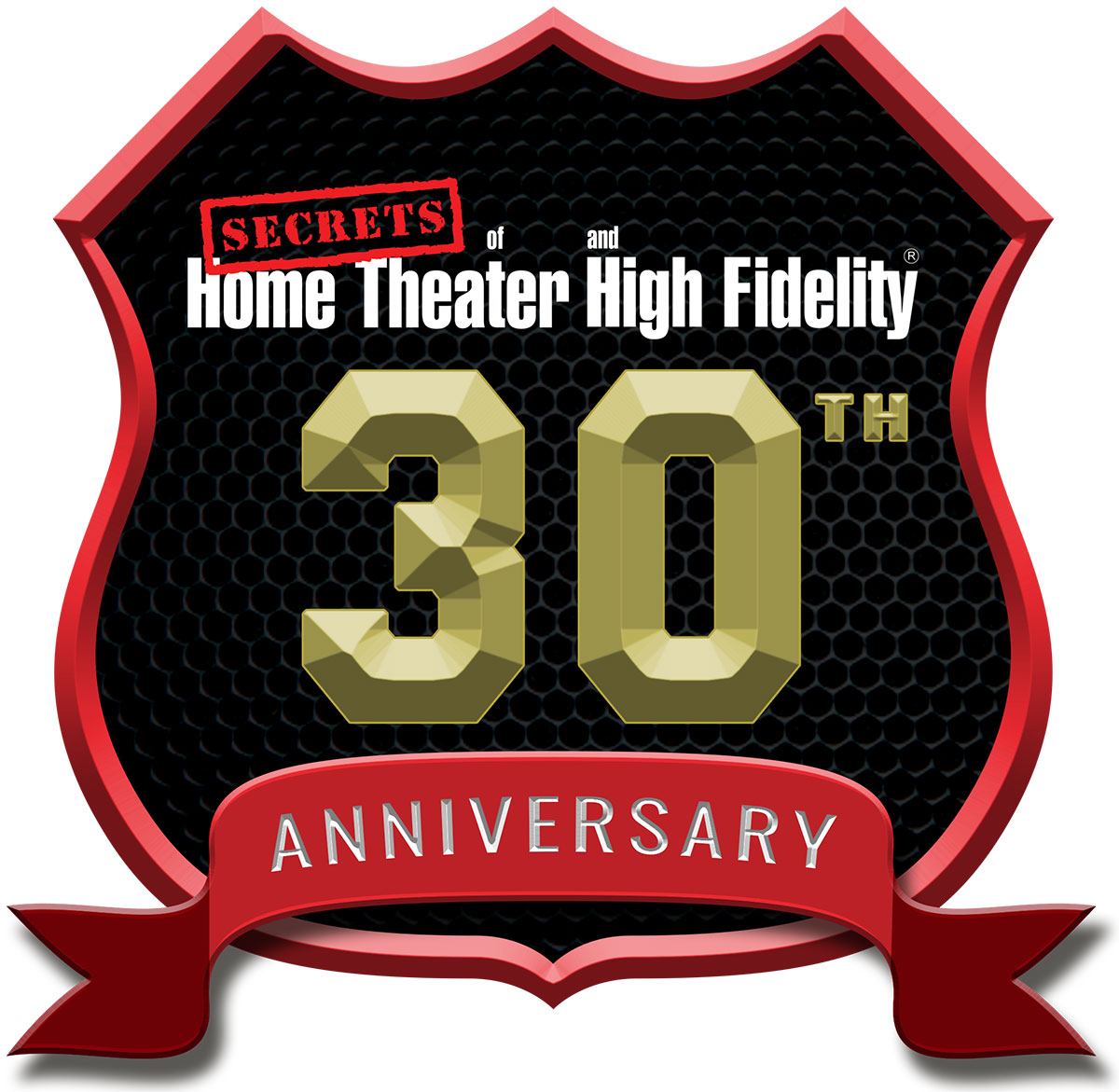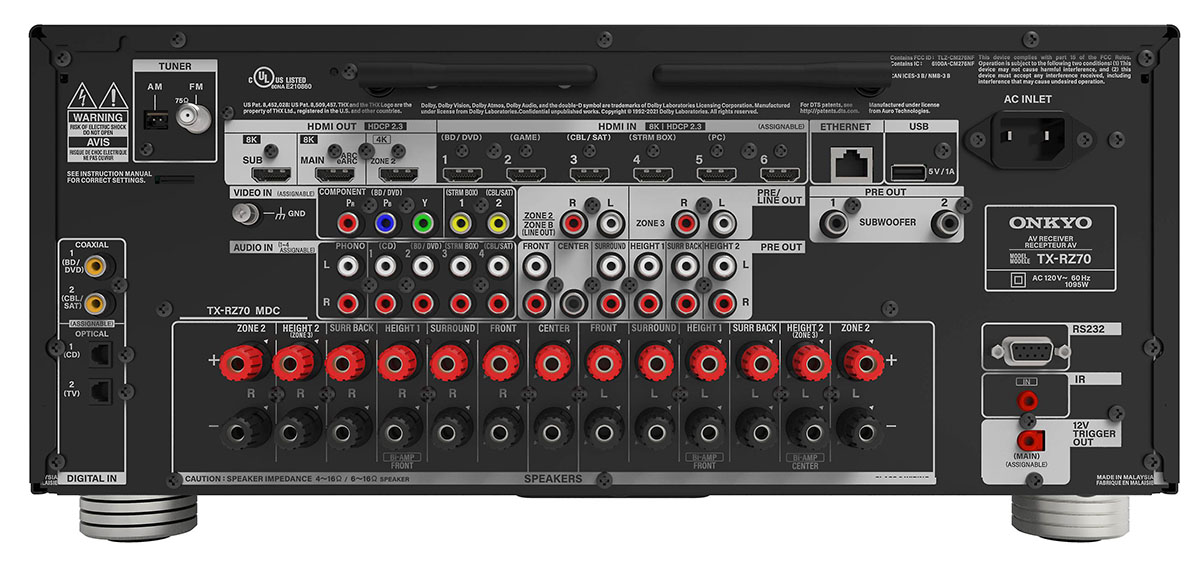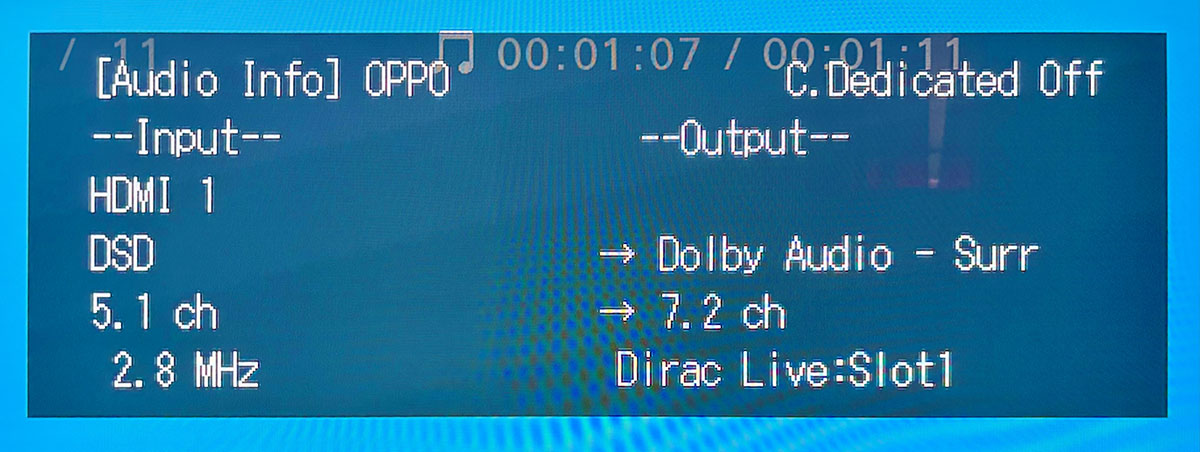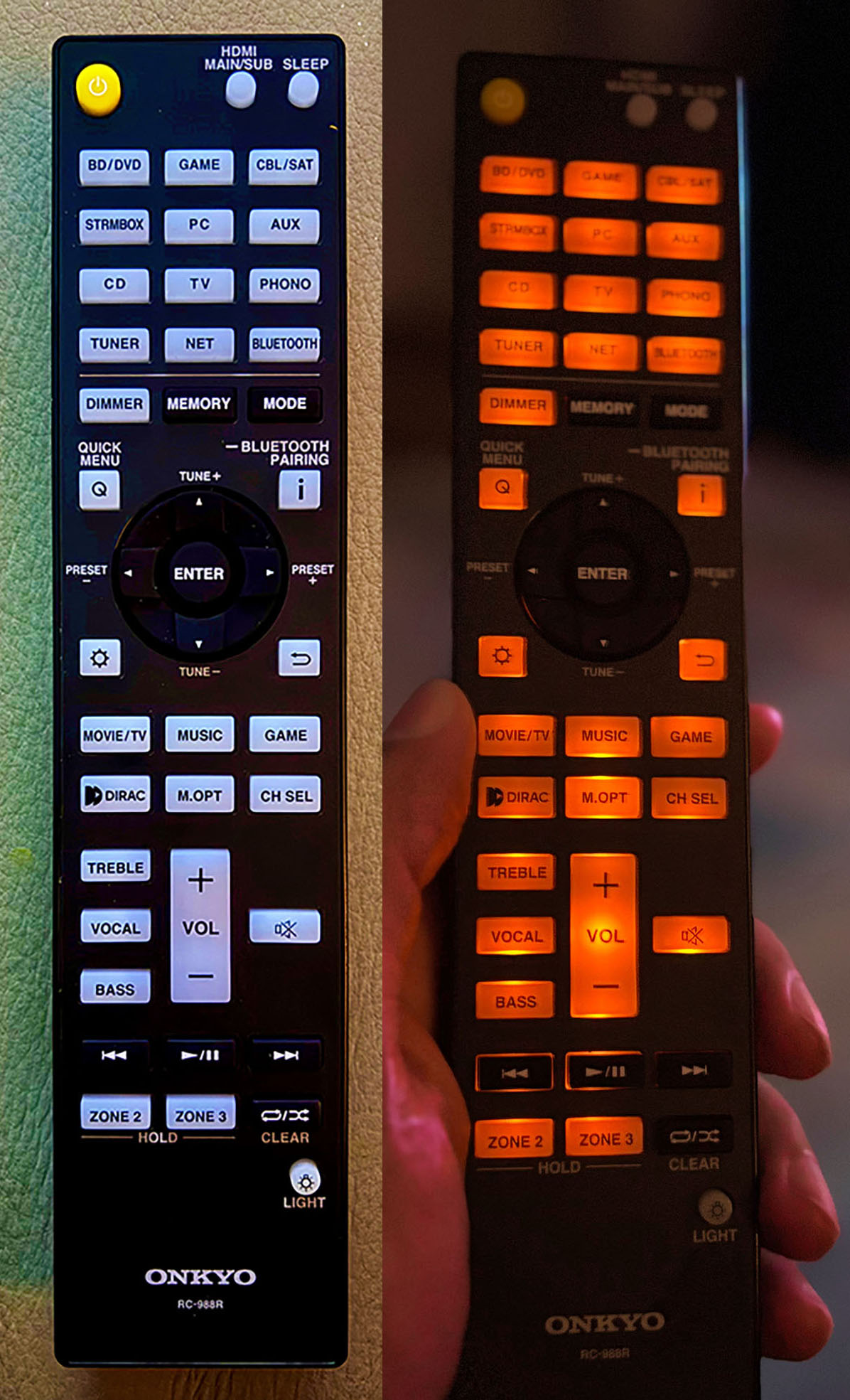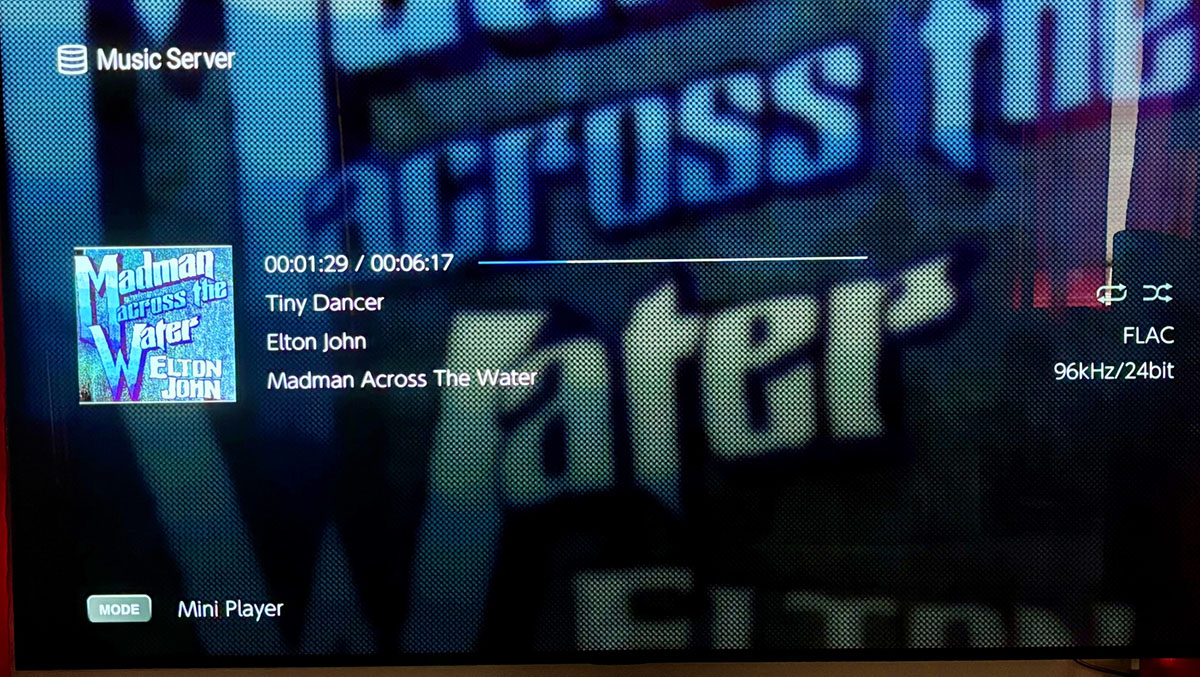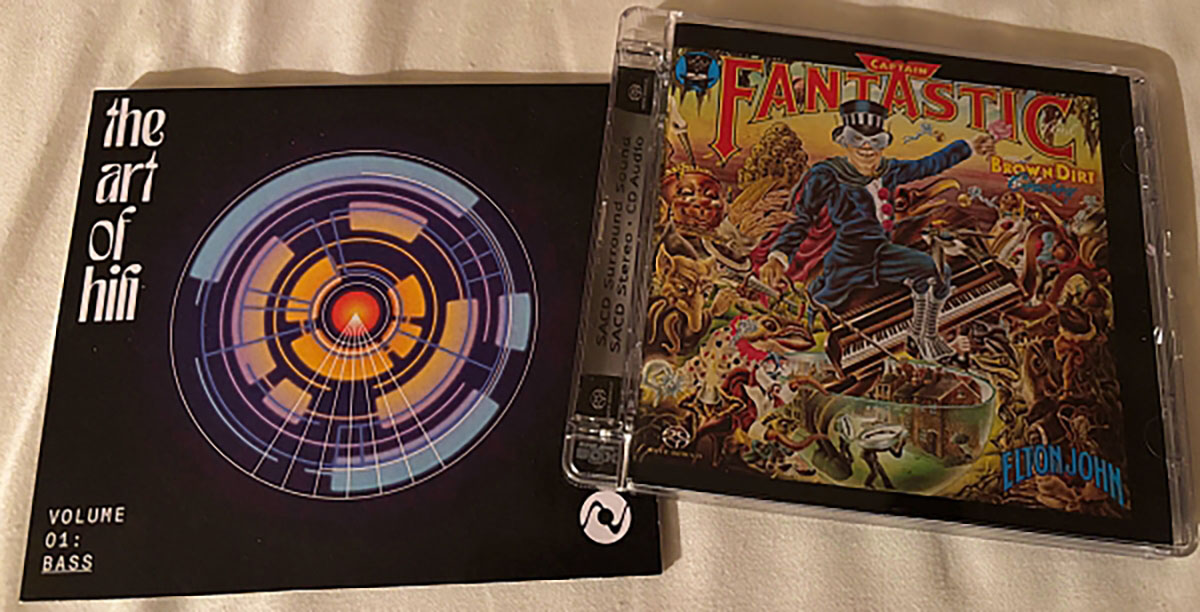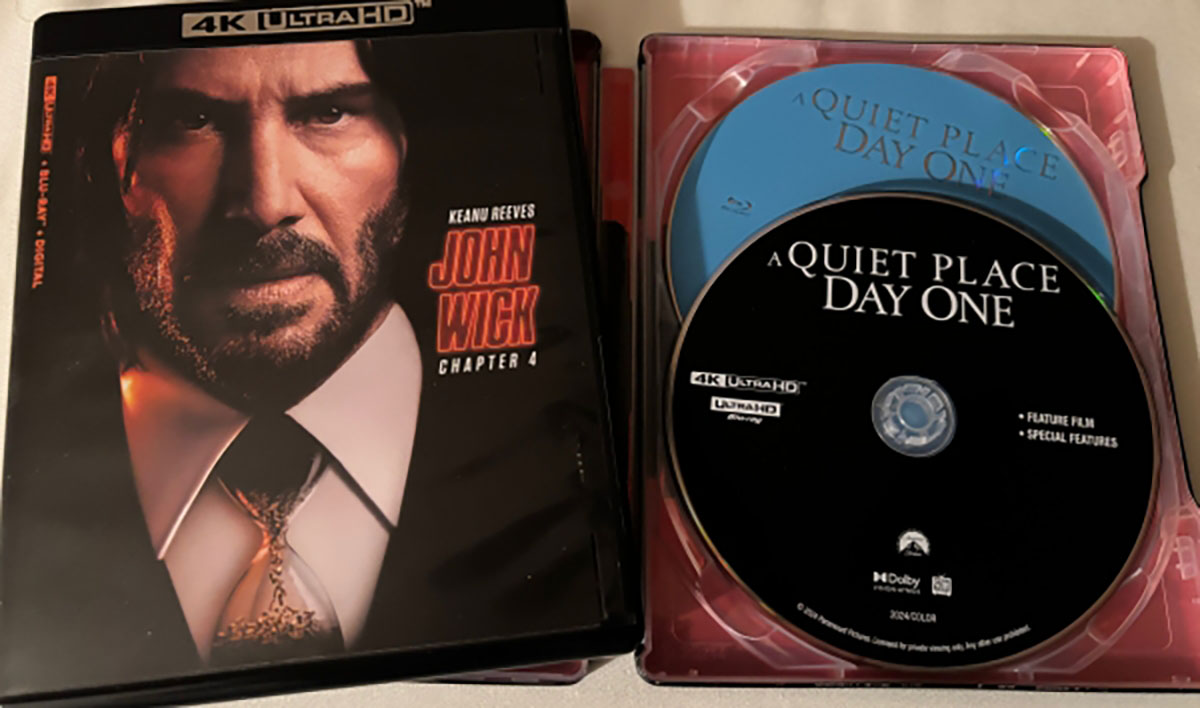Two high-quality ESS9026Pro eight-channel DACs process the audio, and the video can handle resolutions up to 8K at 24, 30, and 60 fps. The Onkyo TX-RZ70 can act as a whole home hub as it provides three separate zones. After a few months with it, I have concluded that it is an incredible deal in the cost/performance ratio analysis for a product of this caliber that retails for under $3,000. Read on to find out why!
Onkyo TX-RZ70 11.2 Channel A/V Receiver
- 11.2 channel amplification with 140 watts of power 2 channels driven (8 ohms/0.08% THD).
- Dirac Live room correction included.
- Klipsch Optimized Mode for those who own Klipsch speakers.
- THX certified (also includes THX Cinema and Music Modes).
- IMAX Enhanced Mode.
- Bluetooth, Wi-Fi, Apple AirPlay 2, Chromecast, DTS Play-Fi and Spotify Connect.
- Dual independent subwoofer outputs (mono).
- Sonos integration.
- Supports high-resolution music files up to 24/192 and DSD playback.
- HDMI 2.1 A/V switching: 7 in, 3 out, and an additional one on the front panel.
- Dolby Vision, HDR10, HDR10+, and HLG (Hybrid Log Gamma) with ARC/eARC.
- Gaming-optimized video processing with VRR, ALLM, and QFT support.
When I started my audio journey in college, I bought a Marantz stereo receiver, the kind with the flywheel radio channel selector. Eventually, with the advent of the new DVD format, I crossed over to an Onkyo home theater receiver (which I have since donated to a family member who still uses it to this day). At that time, Dolby Surround was the new buzzword (the surround channels were mono, but still quite novel), and my passion for movies combined with my love of music. Eventually, I progressed to separates, because, well, they were supposedly better. That said, the complexity of setting up a home theater increased exponentially. More boxes and amplifiers meant more cables and more speakers. Then came subwoofers…not one, but ideally at least two or more! What if I could control everything from a single device that can interpret all the audio codecs, handle the video without harm, and give me lots of power for lots of speakers while providing integration for multiple subs?
The Onkyo TX-RZ70 can handle 11.2, or 7.2.4 speaker configurations. It also has all the latest formats for Dolby Atmos, DTS:X, Auro 3D, and IMAX movie/music modes. It carries THX certification which means it has gone through a third-party series of tests that include thousands of parameters to check for power handling and low distortion. THX certifies that no matter what input or power outputs are used, there can be nothing added, nothing taken away from the original source material. You are still not impressed? It has Onkyo software for basic room correction (which sounded pretty good to my ears) with a supplied mic and Dirac Live at no additional cost! For an extra fee, you can add Dirac Live Bass Control if you have multiple subwoofers in your room. In my review, I used Dirac Live and purchased (for about $100) a calibrated Umik-1 microphone. Dirac Live is arguably the most powerful room correction software on the market today, and it is now easier to use than ever before. It not only sets speaker distances and frequency response but corrects for time domain issues so the sound from all speakers arrives at your ears at the same time.
With 140 watts per channel (two driven), it easily provides over 100 watts per channel x 11. This is more than enough for all but the largest of rooms. Still not enough power for you? The TX-RZ70 can act as a preamp, so the front R/L outs can go to an amplifier of your choice while the receiver powers the rest of your speakers. I eventually used my Benchmark AHB2 amplifier for my main R/L speakers in this configuration. And of course, you can preamp out all the rest of your speakers to separate amps too. Because the internal amp section in the Onkyo is offline while in preamp mode, a cleaner signal is sent to your amps. The Onkyo TX-RZ70 is a heavy, well-built monster of a receiver and I am only getting started on some of its features.
Channels:
11.2 or 7.2.4
Power output:
140WPC @ 8 Ohms
Frequency response:
5 Hz to 100kHz +1/-3dB
THD+N:
0.08% (20 Hz to 20 kHz)
Speaker impedance:
4-16 Ohms
Codecs:
DTS Neural:X, DTS:X, IMAX Enhanced, Dolby Atmos, Dolby Surround, Auro 3D
HDR:
HDR10, HDR10+, Dolby Vision, HLG
Wireless:
AAC, AptX, AirPlay 2, Chromecast, DTS Play-Fi, Roon, Spotify, Alexa, Google Assistant
Inputs:
6x HDMI 2.1 (eARC), 4x stereo RCA, 1x RCA phono, 2x composite, 1x component, 2x coaxial, 2x optical
Front I/O:
1x HDMI input, 1x ¼” headphone, setup mic input
Outputs:
3x HDMI 2.1, 2x subwoofer, 2x stereo RCA, 11-channel pre-outs
Control:
1x RJ-45, 1x 12v trigger, 1x IR input
Speakers:
13x 5-way binding posts
Dimensions (W x H x D):
17.1” x 7.9” x 18.9”
Weight:
48.5lbs
Price:
$2,799
Company:
SECRETS Tags:
onkyo, tx-rz70, av receiver, home theater receiver, multi-channel receiver, receiver, surround sound
- Lyngdorf MP-60 2.1 Home Theater Processor Review
- Marantz CINEMA 30 AV Receiver Review
- Denon AVR-X4800H AV Receiver Review
Secrets Sponsor
Setting up the Onkyo TX-RZ70 was straightforward. All basic command features are located on the front panel. The remote will allow you to access the on-screen display on your TV display as well. I downloaded the Onkyo app onto my iPad which allows for some convenient controls and if you really want to geek out and tweak, you can type the Onkyo’s IP address on your computer browser page and access some very deep-dive setup features. This feature allows for the ultimate ability to configure and includes some interesting features like live updates on the internal temperature of the TX-RZ70. There are a couple of internal fans that kick in from time to time, but when they do, they are barely audible. Even when pushed long and hard, I never felt the receiver get more than slightly warm to the touch. Though this function was there, I found that I never returned to it after the initial setup.
On the remote is a quick on-screen display button that lets you make tweaks while the movie is running, which I found to be handy. Still, the IP access menu allows for tweaking flexibility for those who want to deep dive into the inner workings.
The remote is standard in style and layout. It is backlit, which is a personal requirement of mine for a home theater device. The volume button has a distinct shape that makes it easy to find without looking down. Once you get used to it, most of the features you might use during a movie are easy to find in a darkened room. Of all the receiver remotes I have experienced over time, the Onkyo’s has one of the smartest layouts considering the complexity of the device it controls.
From the front panel, you can adjust the volume, access all the inputs with a single button, operate the Pure Audio mode and tone controls, and choose a specific Listening Mode. Flipping down the front panel door gives you access to more features with a selector wheel for tuning and presets. One HDMI input is also located here which some may find handy. I do wish it also had a USB input because I have several high-res albums on a thumb drive. I can pop it in on the back because I have easy access to it, but if the receiver were in a rack, I am not sure I could find its input by reaching around blindly.
Streaming to the TX-RZ70 was a snap and the front panel display can scroll the title, sampling rate, time, and music mode for you. It can also display info on your TV which looks as good as many stand-alone streamers I have used recently. The Onkyo TX-RZ70 makes a great central hub for movies and music in your home.
Now it is time to get to the crux of the matter. How does the Onkyo TX-RZ70 sound in practice with movies and music? I have listened to many weeks of music and movies and my general impression is quite favorable. The music has a crystal-clear quality, and the surround modes are excellent. I experimented with the Auro 3D and DTS Neural:X modes and liked them sometimes over the Dolby Digital surround mode. The THX Cinema and Music modes were good too, but I recommend listening to sessions in each mode as they bring subtle changes that may or may not appeal to your tastes. The important point is, you have some very solid audio processing modes to select from and that’s a good thing in my book.
Movies had better separation than I have heard from a receiver in recent years, and I have heard many. My wife noticed this while watching a murder mystery on the PBS channel and commented on how lively the new surround process sounded. After running Dirac Live, the bass sounded dynamic and detailed. It integrated well with the GoldenEar T66s which are my current front L/R speakers. All in all, the Onkyo TX-RZ70 upped the ante in my media room for both music and movie playback. It had tons of dynamic power, no audible noise or distortion, ran cool even after extended use, and made me feel I was getting nothing less than an amazing performance. I found the features and sound to be almost night and day different from the Marantz SR 6015…and I really liked the Marantz, too. To be fair, the Marantz had Audyssey XT32, which is quite good, but Dirac Live takes room correction up a notch. (FYI-I have also learned that on Nov. 18th of this month, a software update is coming to the TX-RZ70 that includes some Dirac enhancements, power management tweaks, and other things, but I couldn’t hold my review until they arrived to test them out. It’s nice to know they are continually working on upgrades for their products and getting them out to the consumers).
Most of my music listening these days comes via Qobuz and streaming to the TX-RZ70 was easy, with a scrolling display telling me the title of the music I was listening to as well as the sampling rate and bit depth. High-resolution music sounds excellent on the Onkyo TX-RZ70. If you still spin discs, you will not be disappointed either.
The Art of HiFi Vol. 1 from Octave (PS Audio) Label is a sampler that is entitled Bass. The tracks are various acoustic, electronic, and pipe organ works designed to help you check the bass integration in your system. My setup with two subwoofers is more than enough in my media room. It is not about louder, but better bass throughout the room. If I were to have three or more subs, I might spring for the Dirac Bass and spend the extra coin for it. If you have one or two subs, it might not be a worthwhile expense.
Captain Fantastic and the Brown Dirt Cowboy – Elton John (SACD) has Sir Reginald singing at his prime and the music is somewhat autobiographical, but each song is catchy and wonderfully transferred into surround sound with instruments, backing vocals, and drumming all around. The bass is dynamic and Elton’s voice and piano playing are natural and well centered. A few of his classic albums from the 70s are available on SACD and highly recommended by me. Again, flipping into different surround modes made subtle changes and while some were a bit more aggressive than others, you can pick one that is just right for you. Taken as a whole, the Onkyo TX-RZ70 took my surround music enjoyment up a notch over any receiver I have listened to date. Color me impressed!
John Wick: Chapter 4 is a bit of an over-the-top indulgence that includes tons of action scenes with explosions and gun fights that can wreak havoc on a lesser receiver. The Onkyo TX-RZ70 easily handles the chaos and still maintains clear, audible dialog. If you love action films, the TX-RZ70 had no trouble presenting an amazing sound envelope, especially with Dolby Atmos soundtracks. I never felt that the Onkyo got close to its limit in power output. It also ran cool. I never heard the fans kick in during the show.
Quiet Place: Day One is a prequel in this franchise and may seem like an odd choice for an action movie example. Much of it is dead quiet because sound attracts the monsters that quickly appear to devour you. Because you get accustomed to the quietness, an action scene seems startlingly loud when it happens. I have never felt a more visceral explosion than in the early part of the movie when a vehicle blows up. It was gut-punching. Also, later a thunderstorm came up and the hard rain in all the surrounds was quite life-like. Add the occasional thunderclap and again I was amazed at how realistic it all felt. This type of performance bested a receiver that I reviewed earlier this year that cost almost three times as much as the TX-RZ70 and the TX-RZ70 had more useful features and modes while offering streaming, THX certification, and IMAX Enhanced modes. (The fact that the TX-RZ70 can be found online for under $2K is an astoundingly good deal!)
Secrets Sponsor
The Onkyo TX-RZ70 AV Receiver can deliver brute strength for movies and still caress your music collection with clean wide dynamics and subtle nuances.
- Well-built muscle for movies and music
- Dirac Live included
- Excellent sound quality
- Usable surround modes
- THX certified for exacting A/V performance
- An amazing value in the receiver marketplace
- USB port on front panel
It has been a long time since I had an Onkyo receiver and after reviewing several different receivers over the years, I may have become a bit jaded. The Onkyo TX-RZ70 AV Receiver really opened my ears and eyes to what a receiver benchmark performance can be like. Yes, there could be some that are more “audiophile” or more “cinematic”, but few can do both and do it as well as the Onkyo TX-RZ70 and at such an affordable price. You don’t have to have separates to be in “the game” anymore. Highly recommended!



